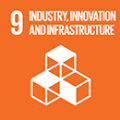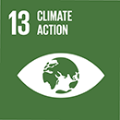The aim of this project is to produce artworks that incorporate energy-efficient elements and slow textile methods to communicate the need to adopt effective sustainable energy strategies in gallery and museum contexts.
Energy Efficient Art
The project addresses the Global Challenge theme of Manufacturing Innovation through collaboration between contemporary arts, materials science, and climate science. The key aim of this project is to produce artworks that incorporate energy-efficient elements and slow textile methods to communicate the stories of our climate and ecosystems.
By combining traditional textile processes including embroidery, with graphene, hand-made electronics, and climate data, the project produced the exhibition Spinning World at the exhibition at the Museum of Applied Arts and Sciences.
By investigating methods of production, the project demonstrated the ways in which artworks convey the stories of our climate and our ecosystems through aesthetic elements, emerging materials research, and climate science data.
This project involved a sustainable assessment of the materials used including sourcing and production in order to identify ecologically sustainable methods for art production.
Materials science, slow textiles & ecological futures
The team
This project brings a team of experts in textiles and electronic media art, material science, and climate science.
Dr Jo Law, Senior Lecturer, School of the Arts, English and Media, Faculty of the Arts, Social Sciences and Humanities. Dr Law is an artist and early career researcher who investigates the transformative potential of art, science, and technology. Her transdisciplinary research focuses on the role of innovative art and design within our changing sociocultural and political environments. She will bring her research expertise in electronic media applications to the project. She will lead this creative practice-led transdisciplinary research project with Dr Agnieszka Golda.
Dr Agnieszka Golda, Senior Lecturer, School of the Arts, English and Media, Faculty of the Arts, Social Sciences and Humanities. Dr Golda is an artist researcher specialising in textiles and collaborative mixed-media installation art. Her research focuses on the intersection between nature, human and nonhuman in contemporary art, specifically investigating how materials and sculptural forms can transform attitudes towards the natural world. She will bring her expert knowledge in textile and fibre technologies to the project.
Dr Sepidar Sayyar, Associate Fellow, Intelligent Polymer Research Institute, Australian Institute of Innovative Materials Research Facility. Dr Sayyar is a fabrication/material scientist at Australian National Fabrication Facilities. His current research includes fabrication of biomedical scaffolds, preparation of conducting composites, synthesis of biocompatible composites, and synthesis of graphene. Dr. Sayyar has extensive knowledge in the development and processing of nanocomposite materials and will lead the experiments in material production in this project specifically investigating ecologically sustainable approaches and solutions in graphene application.
Professor Helen McGregor, ARC Future Fellow, School of Earth and Environmental Sciences, Faculty of Science, Medicine and Health. Professor McGregor is an Australian climate change researcher with expertise including isotope geochemistry, palaeoclimatology, climate change processes and Quaternary environments. Her research improves our ability to forecast climate change and addresses key questions on the origins of natural climate variations. She will contribute expertise in climate science for understanding climate and the impact of human induced climate change. Her participation will allow her to investigate art as a means of communication in the context of climate science.



 .
.  .
.